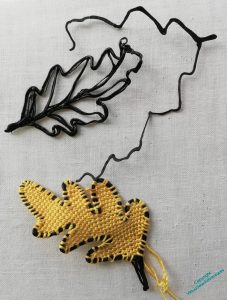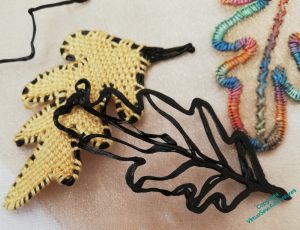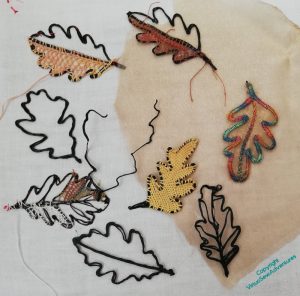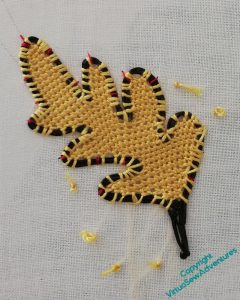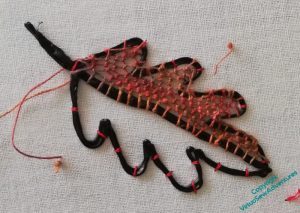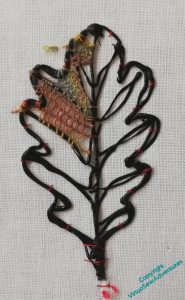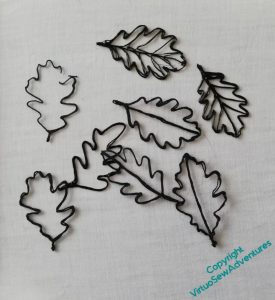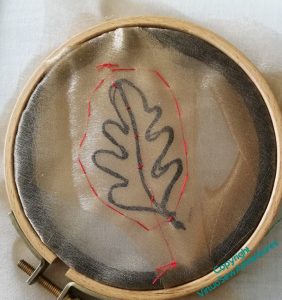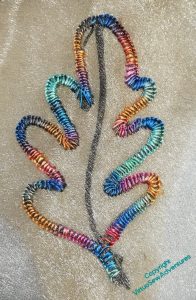Tag: Oak Leaf Wreath
Oak Leaf Wreath Testing
I mentioned that I had more experiments to perform on the leaves, and several people hastened to tell me that I should be sure to Test To Destruction. They are right, of course, and having plenty of samples in the pack that Caroline Hack sent me to play with, I was able to do just that.
One of them, I pulled and twisted, trying to snap the plastic. That turned out to be much harder than I had expected it to be, considering how flimsy it felt when I was nervously working needlelace over the leaf shapes.
Then I fished out the heat gun that I still have left over from some experiments with paper crafting, covered a drinking glass with a bit of greaseproof paper, and tried to soften the plastic so it would match the curve of the glass. The plastic certainly moved, but not in a very controlled fashion, so I tried again, this time using one of my needlelace experiments. It was still an undercontrolled shift, but it did produce the sort of twisted look of a drying leaf. I tried hard to photograph it so that the curves really showed!
I worked a series of experimental needlelace sections in some of the other pieces. Knotted stitches in slubby linen (really don’t do this – friction becomes a real problem!), cloth stitch in silk (the yellow that in due course was melted and twisted) and a variety of others.
I think, in the end, the difficulty of covering the borders, and the slippy plastic which makes it hard to keep the threads in place, mean that this won’t be the best way to do the oak leaf wreath. I may still have thoughts about this as I begin to plan, and in particular, I need first of all to work out how big my oak leaves need to be in order to be in proportion with the mirror.
You can now watch Episode 67 of SlowTV Stitchery, which is entirely concerned with my battles with Swirl Stitch!
More Needlelace Experiments
I wasn’t at all sure how to tackle the Oak Leaf Wreath Experiments, but as always, charging in head over heels is the most enlivening strategy!
Having toyed with the idea of these drawn plastic oak leaves as the support for fabric leaves, I thought the next thing to play with would be needlelace, using different types of thread and different stitches. I want to get some sense of how to tackle a very difficult shape, and I think that even if I choose not to use the plastic pen, I will have learnt a great deal from the different combinations I’ve experimented with.
The first one uses a fairly heavy silk thread, not quite a perlé, but definitely not stranded. The stitch is the classic Corded Brussels Stitch.
I don’t think that this combination of thread and stitch leaves space to cover the plastic easily or neatly, and I can’t think of another way to tidy up all the ends I needed to use because of the uneven shape.
Also, my goodness, the plastic is slippery. Placement of rows might prove to be a bit of a challenge.
The next one is a rather finer linen thread, and I started from the extra line of plastic down the middle, which may have slightly simplified the stitching. There is probably enough space for a buttonhole stitch covering for the edge, but it was very hard to fit the needle around the more confined areas. Maybe I could devise some way to cover the edges once the leaf was off the backing?
The linen is a hard thread to work with, because the friction of the thread against itself it quite high, and since I chose a knotted stitch for this experiment, there was a lot of friction!
The final experiment for this week used a single strand of stranded silk. Caroline added veins to this one, and I tried to fit two different stitches around the veins and over the edges. Definitely not straightforward!
I found myself wondering about finding shorter needles for this project, maybe more like my Japanese needles, but blunt (the Japanese needles are super-sharp!). I’ve found the balance of the Japanese needles a bit challenging in the past, but fitting around the edges and corners of these shapes has also been a bit challenging.
What’s that saying about picking your battles?
And in the meantime, Episode 62 of SlowTV Stitchery is now live. In which we discuss Why The British Talk About The Weather, consider discoveries in the loft, and contemplate the placement of the needlelace slips.
More Experiments!
I have a rather nice circular wall mirror that my uncle passed on to me, which was his mother’s. That makes it close to a hundred years old, more than likely, and it occurred to me one day that it might enjoy having a stumpwork oak leaf frame.
Then one of the other embroiderers who joins in Hand Embroidery Hour on Twitter, the textile artist Caroline Hack, mentioned a new toy – a pen which allowed her to draw and create plastic outlines. Now, I know that there is perfectly ordinary cake-decorators wire to do the job, but I wondered whether this new material would add anything to the experiment. Like the star she is, Caroline drew a few oak leaf variations for me to play with, some with veins, some not, some using more passes of the pen, and some not, and posted them.
My first experiment plays with gauze. I’m thinking that the oak leaf frame might include some fabric leaves, as well as needlelace. After all, the mirror is a foot across – a wreath would involve a LOT of leaves!
So in this case, I have entrapped my leaf shape between two layers, tacking roughly around the edges to control the second piece of gauze, and very carefully down the central vein so that the leaf shape would stay where I wanted it to. Even by my standards, this is an odd proceeding…
I thought that while I was throwing experimental ideas together I would see whether the slight “spreading” qualities of floss silk help to cover the plastic outline, because gauze tends to ladder if you stitch it too closely. I don’t mind that if it’s part of the plan, but it’s better to know how to avoid it if you want to!
It was certainly an interesting experience. I didn’t quite get the floss silk to spread as much as I might have hoped, and there were some rather tense negotiations between the needle and the few points where there were two separate lines in the leaf shape.
I haven’t yet had the nerve to cut it out!
Episode 56 of SlowTV Stitchery is now live. In which I continue to make progress, almost silenced by the unnerving freedom offered by a Year of Experiments..

